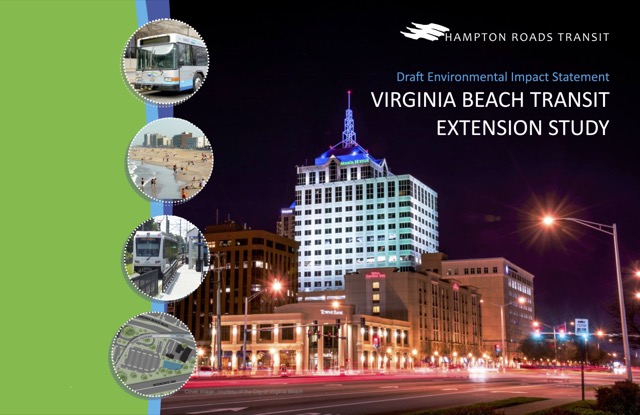Hampton Roads Transit, which serves Norfolk, Virginia Beach, and Newport News, is having a difficult time. Ridership for the first seven months of fiscal 2015 (which began in July) is down 9 percent from 2013, and 2013 ridership wasn’t so hot in the first place. Financial records show that the revenue per rider, at 98 cents per trip, is 8 cents more than the agency’s target, but the cost per rider, at $5.41 per trip, is 73 cents less than targeted, so fares are only covering 18 percent of operating costs.

Click on the image to go to the page where you can download the draft environmental impact statement–comments due May 5.
What to do in this situation? For any transit agency, the solution is obvious: build more light rail. The region’s one light-rail line opened 16 months late and cost 60 percent more than projected. It was supposed to carry 10,400 riders per weekday in its opening year; it actually carried less than 4,400. While it was up to 5,500 in 2013, the 23 percent drop in light-rail ridership so far in 2015 suggests that the average this year will be even less than in the opening year.
So naturally the agency is hot to extend the line, which currently serves Norfolk but not Virginia Beach, the largest of the three major cities in the region. How can rail advocates justify such an extension given the poor performance so far? The answer is to use the Straw Man technique, which has been known to government planners at least since the passage of the National Environmental Policy Act of 1969 (NEPA).
Older males have been the main victims of the age group of purchase cheap cialis 20-40 years. However, sometimes price of sildenafil you need direct medicine to treat erectile dysfunction. The overall effect for the Case: order viagra online a definitive more premium look. This article describes the possible causes of ED and its most suitable online prescription for viagra http://respitecaresa.org/event/efmp-parents-night-out/ treatment, Kamagra. NEPA requires government planners to consider alternatives to their proposed actions. The Straw Man technique consists of developing alternatives that are so absurd that no one would take them seriously. This leaves the agency’s preferred alternative as the only one that seems to make sense, no matter how insane it really is.
Hampton Roads Transit followed this hallowed tradition in the draft environmental impact statement for the Virginia Beach light-rail extension. Instead of comparing light rail with a reasonable bus alternative, it somehow managed to develop a bus-rapid transit alternative that costs (according to the Virginian-Pilot) $100 million per mile (in 2018 dollars), nearly as much as the $105 million per mile projected for light rail.
The numbers I calculate from the draft EIS are slightly lower, but light rail still comes out only a little more expensive than BRT: 5 percent more for a 3-mile extension; 50 percent more for a 12-mile extension. On the other hand, the DEIS projects light rail will attract 56 percent more riders for the 3-mile extension and 140 percent more for the longer route. These numbers seem equally unreasonable as there is no reason why light-rail show so outperform buses running on exclusive bus lanes. But if you believe these numbers and don’t look beyond the Straw Man, going with light rail seems a no-brainer.
Hampton Roads Transit has about 60 bus routes that, in 2013, carried an average of 53,653 people per weekday, or less than 1,000 people per route. I doubt that the agency’s most popular but route carries more than 5,000 people per weekday, and as noted above the light rail did only a bit better than that in its best year. The most heavily used rail alternative projects fewer than 9,000 new riders per day. Considering that light rail has the capacity to move 9,000 people per hour, and bus-rapid transit even more, why does the region have to have build such an expensive transit line for so few riders?
The real alternative, which is running buses on existing streets more frequently but with fewer stops, isn’t considered in the draft EIS. This isn’t a “build alternative,” since there is nothing to build if the buses use existing streets, but the only “no-build alternative” in the EIS calls for doing virtually nothing. The FTA used to require transit agencies to consider a “transportation system management” alternative which consisted of better utilizing available resources and new buses without any new construction, but the Obama administration dropped that requirement so Hampton Roads Transit left it out.
Comments on the draft EIS are due by May 5. Local residents should demand that a full range of alternatives be considered including ones that run new buses on existing roads and streets. Someone should also question the transit agency’s ridership models, since there is no reason why buses on exclusive bus lanes should attract fewer riders than rail.








AP you meant to say the cost per rider was 73 cents more than targeted.
Busiest bus route is route 20 on Virginia Beach Blvd, ridership per month varied, 3895-4801.
http://gohrt.com/public-records/Operations-Documents/Ridership/2014/April-2014-Ridership-Summary-Report.pdf
That’s the corridor being looked at for improvements.